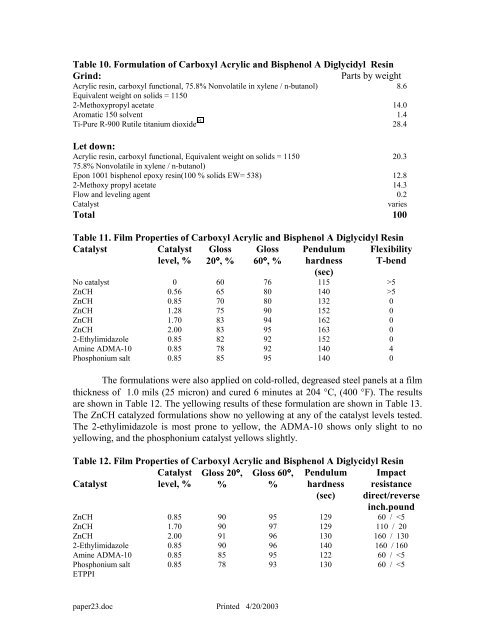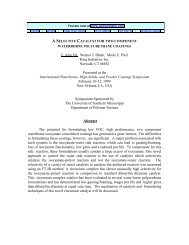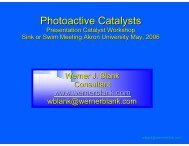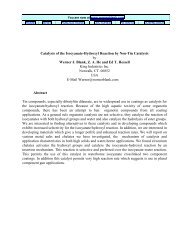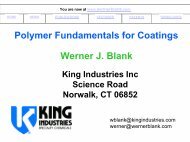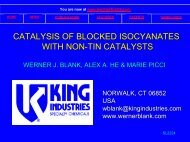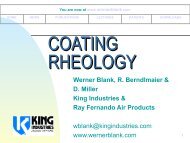Catalysis of the Epoxy-Carboxyl Reaction - Werner Blank
Catalysis of the Epoxy-Carboxyl Reaction - Werner Blank
Catalysis of the Epoxy-Carboxyl Reaction - Werner Blank
Create successful ePaper yourself
Turn your PDF publications into a flip-book with our unique Google optimized e-Paper software.
Table 10. Formulation <strong>of</strong> <strong>Carboxyl</strong> Acrylic and Bisphenol A Diglycidyl Resin<br />
Grind: Parts by weight<br />
Acrylic resin, carboxyl functional, 75.8% Nonvolatile in xylene / n-butanol)<br />
Equivalent weight on solids = 1150<br />
8.6<br />
2-Methoxypropyl acetate 14.0<br />
Aromatic 150 solvent 1.4<br />
Ti-Pure R-900 Rutile titanium dioxide 35 28.4<br />
Let down:<br />
Acrylic resin, carboxyl functional, Equivalent weight on solids = 1150<br />
75.8% Nonvolatile in xylene / n-butanol)<br />
Epon 1001 bisphenol epoxy resin(100 % solids EW= 538) 12.8<br />
2-Methoxy propyl acetate 14.3<br />
Flow and leveling agent 0.2<br />
Catalyst varies<br />
Total 100<br />
Table 11. Film Properties <strong>of</strong> <strong>Carboxyl</strong> Acrylic and Bisphenol A Diglycidyl Resin<br />
Catalyst Catalyst<br />
level, %<br />
Gloss<br />
20°, %<br />
Gloss<br />
60°, %<br />
paper23.doc Printed 4/20/2003<br />
Pendulum<br />
hardness<br />
(sec)<br />
20.3<br />
Flexibility<br />
T-bend<br />
No catalyst 0 60 76 115 >5<br />
ZnCH 0.56 65 80 140 >5<br />
ZnCH 0.85 70 80 132 0<br />
ZnCH 1.28 75 90 152 0<br />
ZnCH 1.70 83 94 162 0<br />
ZnCH 2.00 83 95 163 0<br />
2-Ethylimidazole 0.85 82 92 152 0<br />
Amine ADMA-10 0.85 78 92 140 4<br />
Phosphonium salt 0.85 85 95 140 0<br />
The formulations were also applied on cold-rolled, degreased steel panels at a film<br />
thickness <strong>of</strong> 1.0 mils (25 micron) and cured 6 minutes at 204 °C, (400 °F). The results<br />
are shown in Table 12. The yellowing results <strong>of</strong> <strong>the</strong>se formulation are shown in Table 13.<br />
The ZnCH catalyzed formulations show no yellowing at any <strong>of</strong> <strong>the</strong> catalyst levels tested.<br />
The 2-ethylimidazole is most prone to yellow, <strong>the</strong> ADMA-10 shows only slight to no<br />
yellowing, and <strong>the</strong> phosphonium catalyst yellows slightly.<br />
Table 12. Film Properties <strong>of</strong> <strong>Carboxyl</strong> Acrylic and Bisphenol A Diglycidyl Resin<br />
Catalyst<br />
Catalyst<br />
level, %<br />
Gloss 20°,<br />
%<br />
Gloss 60°,<br />
%<br />
Pendulum<br />
hardness<br />
(sec)<br />
Impact<br />
resistance<br />
direct/reverse<br />
inch.pound<br />
ZnCH 0.85 90 95 129 60 /


